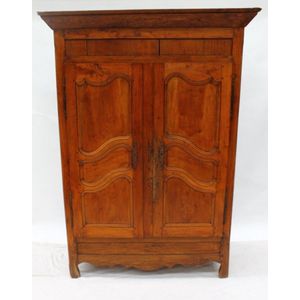Louis XV Provincial Oak Buffet, Early 19th Century
You must be a subscriber, and be logged in to view price and dealer details.
Subscribe Now to view actual auction price for this item
When you subscribe, you have the option of setting the currency in which to display prices to $Au, $US, $NZ or Stg.
- Apron - A decorative wooden panel that sits underneath the top surface of a table or chair, and unites the top of the piece with the legs, running at right angles to the underside. On carcase furniture such as a chest or wardrobe, the apron sits below the drawers or doors and attaches to the legs.
On carcase furniture without legs the panel under the drawers or doors sits on the floor and is termed a plinth.
An apron can provide a decorative touch to an otherwise unadorned piece of furniture and at the same time provide structural support and strength. They can be carved or pierced and quite elaborate. - Stile - A cabinetmaker's term that refers to the vertical end members of the framework in a panelled item of furniture. The vertical mid-members are known as muntins.
- Fielded Panel - A recessed panel, where the outer edges have been bevelled or chamfered. The central section of the panel is thus raised or 'fielded'. The field may follow a variety of shapes square, rectangular, rounded or shield shaped. Fielded panels are found on many cabinet doors made over the past several centuries. On some chests, the drawer fronts may also be fielded
- Frieze - An architectural term denoting the flat, shaped or convex horizontal surface of furniture, between the architrave and the cornice, usually found on a cabinet or bookcase, or on desks and tables where it may include drawers, the area between the top and the legs. In ceramics, the term refers to the banding, of usually a repeating pattern, on the rims of plates and vases.
- Oak - Native to Europe and England, oak has been used for joinery, furniture and building since the beginning of the medieval civilisation. It is a pale yellow in colour when freshly cut and darkens with age to a mid brown colour.
Oak as a furniture timber was superceded by walnut in the 17th century, and in the 18th century by mahogany,
Semi-fossilised bog oak is black in colour, and is found in peat bogs where the trees have fallen and been preserved from decay by the bog. It is used for jewellery and small carved trinkets.
Pollard oak is taken from an oak that has been regularly pollarded, that is the upper branches have been removed at the top of the trunk, result that new branches would appear, and over time the top would become ball-like. . When harvested and sawn, the timber displays a continuous surface of knotty circles. The timber was scarce and expensive and was used in more expensive pieces of furniture in the Regency and Victorian periods. - Panels - Timber pieces, usually of well-figured wood either recessed or applied over the frames of doors and as decoration elsewhere in the carcase of cabinet furniture. The panels may take a variety of shapes rectangular, square, shield shape, oval, half-round or in the form of Egyptian pylons.
This item has been included into following indexes:
- cabinets, material - oak 563
-
cabinets, period or style
- French 732
- Louis XV style 194
- cabinets, type - buffets, French 303
Visually similar items

An oak Breton storage cupboard, circa 1950, with two panelled upper cupboards carved in the typical manner with male and female Breton figures carrying wheat and scythes above two smaller cupboards with internal shelving and carved with roundels of faces i

French Louis XV style cherry wood two door, three drawer buffet, approx 91 cm high, 138 cm wide, 48 cm deep

An antique French armoire in cherry & oak, three fitted Baltic pine shelves, the original hinges & lock in tact, excellent original condition, 195 x 140 x 51 cm

George III oak sideboard, c. 1780, the frieze with three drawers, above three further drawers, flanked by cupboards, raised on bracket feet, height 93 cm width 183 cm depth 50 cm. Provenance: Auchinachie Antiques, Woollahra, NSW
